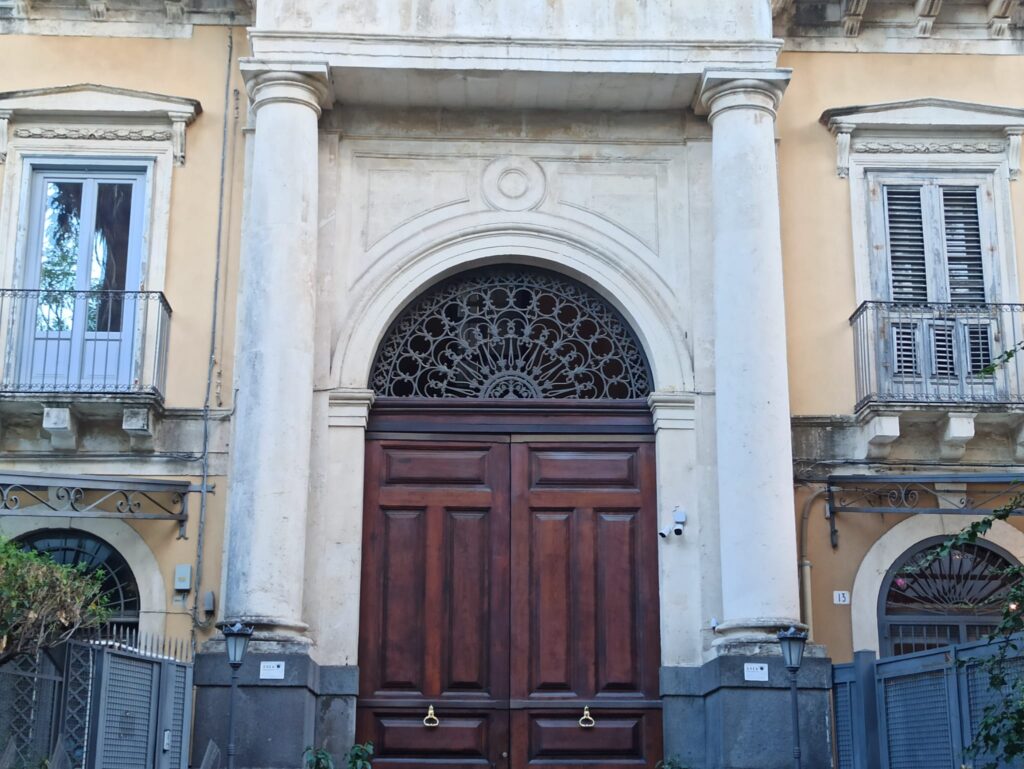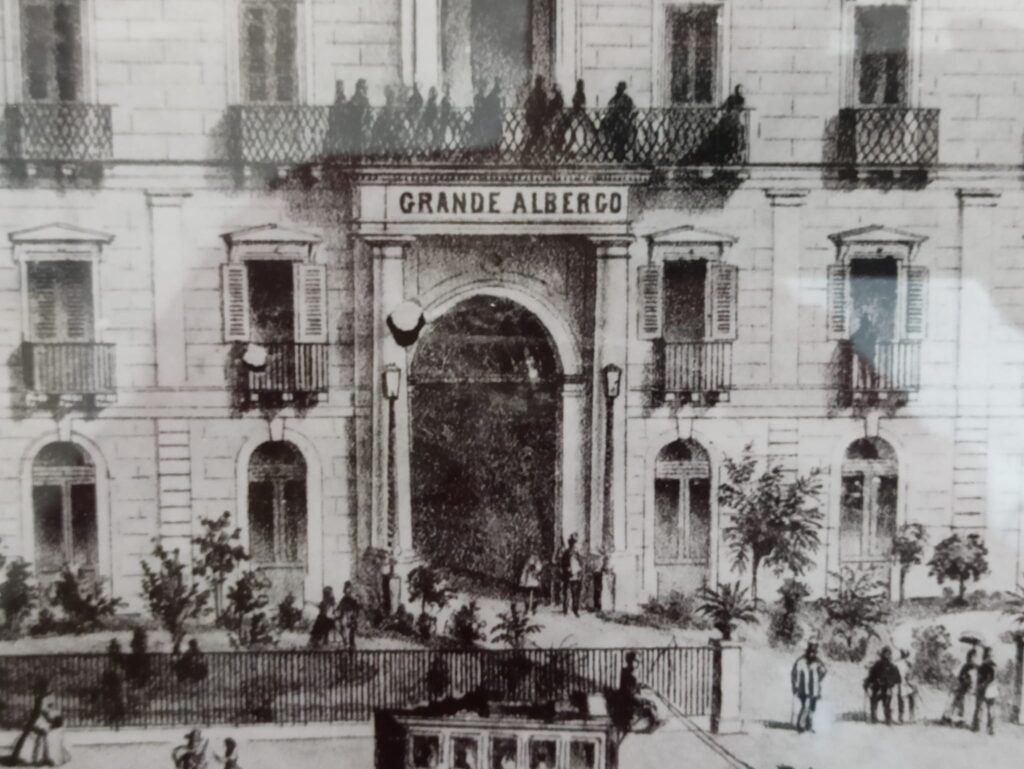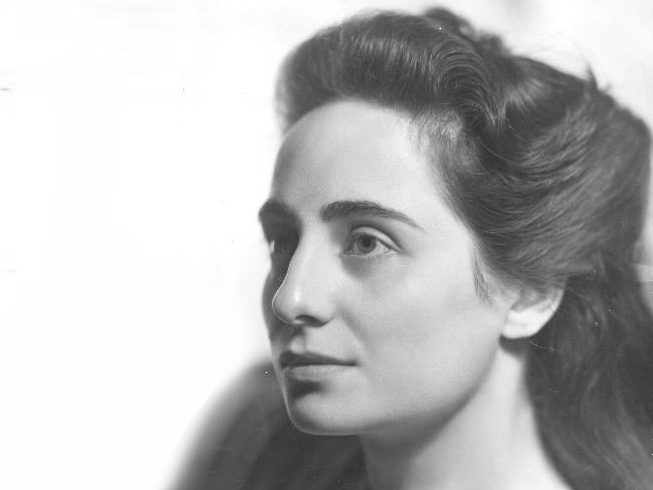
In 2012 the Società Italiana Letterate decided to fix a plaque on the façade of a building at 20, via Pistone – Catania. It tells: “Questa casa, la strada, i vicoli, Catania, la terra di Sicilia hanno nutrito il genio narrativo di Goliarda Sapienza (1924 – 1996)” [This house, the street, the alleyways, Catania and Sicily cherished Goliarda Sapienza’s fictional spirit (1924-1996)]. Before moving to Rome in 1941 and attend the Accademia d’Arte Drammatica, Goliarda spent some time of her life at the second floor of this building indeed.
This is where she learnt music from Libero and philosophy from Ivanoe, her brothers[1]. Also, this is where her father, the lawyer Peppino Sapienza, spent his last years and where his funeral procession started on 27th November 1949 to go across the city for the farewell[2]. Some years later, the director Citto Masselli and Goliarda uncovered some copies of the Italian socialist newspaper “L’unione”, which had been hidden behind some tiles, and gave them to the library of Fondazione Giangiacomo Feltrinelli[1].
So, this apartment was really meaningful to her but was not her house of birth.
Before living in Via Pistone, the Sapienza-Giudices had lived in three apartments at least. In 1929 in via Enrico Pantano 81[3] and in 1928 in Piazza Manganelli 3[4]. Nevertheless, finding out where Goliarda was born implies looking back at the time she had not been born, the years when her father Giuseppe Sapienza, socialist and antifascist, had begun his carrier.
Giuseppe, whose nickname was Peppino, was born in Catania in 1884[5]. He was the last son of Alfio Sapienza from Viagrande (a village in the surroundings of Catania) and Agata Spoto and the first member of his working family to study at university. First he got a degree in primary school teaching and graduated in Law later (in 1915)[6].
His parents got married in Catania in 1863[7], the same year when their first daughter was born[8]. His brother Nunzio[9], as Goliarda told many times, was eighteen years older than Peppino. Peppino’s father was a cook whereas his grand-parents had been cobblers, as some of his siblings had been as well. In 1905[10] Peppino was still a student when he married Lucia Musumeci. They had three kids. This was the time when he and his family lived in the city center, namely in Via Idria 1 in 1907[11] and in Via Filippini 19 (via San Francesco, today)[12] from 1909[13] to 1915[14] (i.e. from their second son’s birth to his wife’s death). This dwelling was near the Corte d’Assise, the Law Department of the university and the venue of the General Confederation of Labour. He was elected as its leader in 1912[15].
Some time later he met Maria Giudice, with whom he started a new family. Thus, as he needed a more suitable dwelling for this new wider family, he rented an apartment in Piazza Cappellini 13 (Piazza Falcone, today) at Palazzo Fischietti from 1921[16][17] to 1927[18].
Goliarda Sapienza was born there in 1924[19], in the same building that hosted the famous actress Sarah Bernhardt 35 years before[20].
The setting of Piazza Falcone has almost kept its characteristics, despite the destruction of San Berillo area at the end of 1950s.
On one side, we find the Santissimo Crocifisso della Buona Morte Church that was built in 1837[21]. On the other, we find Palazzo Fischietti, which was built by the entrepreneur Rosario Fischietti around 1840. It was a textile plant at the beginning, but later was converted into the “Grande Albergo” (Great Hotel) of Catania in 1873. It counted more than 100 rooms and hosted some of the most notorious personalities of the time.
In 1911 it was again converted in a block of apartments and offices[20][22], namely the office of the Genio Civile (Office for Civil Engineering). Its address was Piazza Cappellini 13 from 1931[23].
With the following renovations of the square, the once open and accessible garden[20][24] was incorporated in the exclusive property of Palazzo Fischietti and marked out with the current fence and gates (street numbers 1, 3 and 5).
Hopefully, the pre-existing street numbers have been kept: number 13 is still there, on the right side of the huge arch gate.


I thank Cono Cinquemani for giving me the opportunity to add an important element to Goliarda Sapienza’s biography with my research.
[1] Trevisan, Alessandra. Per una ricerca sugli inediti di Goliarda Sapienza: nel «baule mentale» della “personaggia” [tesi di dottorato di ricerca in Italianistica]. Università Ca’Foscari di Venezia, 2020.
[2] Unanime cordoglio della città: L’ultimo addio a Peppino Sapienza, «La Sicilia», 28/11/1949, pagina 2.
[3] Calapso, Jole. Una donna intransigente: vita di Maria Giudice. Italia, Sellerio, 1996.
[4] 1928 Death Sapienza Goliardo Danilo – Catania Record 2297.
[5] 1884 Birth Sapienza Giuseppe – Catania – Record 1066.
[6] Grimaldi, Laura e Carbone, Salvatore. Il popolo al confino: la persecuzione fascista in Sicilia. Italia, Ministero per i beni culturali e ambientali, 1989.
[7] 1863 Marriage Sapienza Alfio and Spoto Agata – Catania – Record 3.
[8] 1863 Birth Sapienza Rosa – Catania – Record 265.
[9] 1866 Birth Sapienza Nunzio – Catania – Record 3017.
[10] 1905 Marriage Sapienza Giuseppe and Musumeci Lucia – Catania – Record 447.
[11] 1907 Birth Sapienza Alfio Goliardo – Catania – Record 232.
[12] Costa, Francesco. San Francesco all’Immacolata di Catania: guida storico-artistica. Italia, Biblioteca Francescana, 2007.
[13] 1909 Birth Sapienza Libero Salvatore – Catania – Record 4353.
[14] 1915 Death Musumeci Lucia – Catania – Record 134.
[15] Merode, Giovanni e Pavone, Vincenzo. Catania nell’età del fascismo 1922-1945. Catania, Edizioni Greco, 1985.
[16] 1921 Death Sapienza Goliarda – Catania – Record 2701.
[17] 1923 Death Civardi Danilo – Catania – Record 2141.
[18] Annuario del Ministero della giustizia e degli affari di culto. Italia, 1927.
[19] 1924 Birth Sapienza Goliarda – Catania – Record 3927.
[20] Newspaper clippings and documents in the possession of Professor Ester Lombardo, descendant of Rosario Fischetti.
[21] Gentile Cusa, Bernardo. Piano regolatore pel risanamento e per l’ampliamento della città di Catania. Italia, C. Galàtola, 1888.
[22] Facebook page post “Obiettivo Catania” (now “Melior de cinere surgo – Obiettivo Catania”).
[23] Annuario del Corpo reale del Genio civile. Italia, 1931.
[24] “Grande Albergo” built by Fischetti in Piazza Cappellini and inaugurated in 1873, in a reproduction of a print of the time kept at the Confagricoltura of Catania.






Grandissimo lavoro!